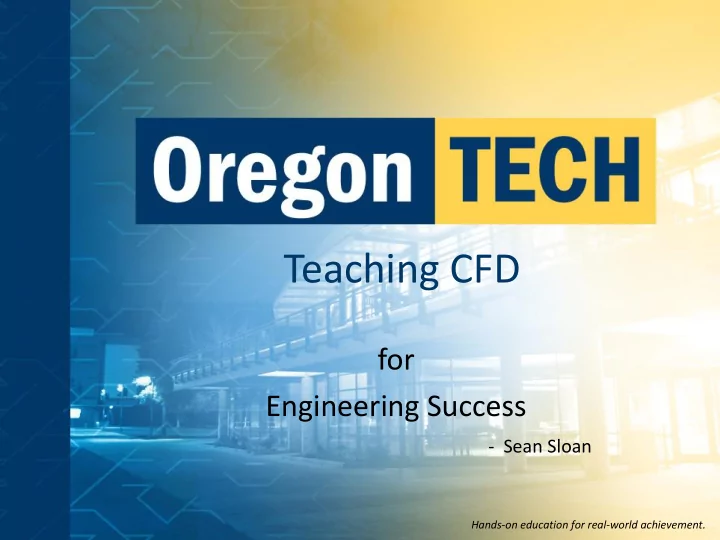

Teaching CFD for Engineering Success - Sean Sloan Hands-on education for real-world achievement.
Mission • 14 students • 20 weeks of fluids background • Can they intelligently use CFD within a 10 week period? • New Course MECH 407 – Computational Fluid Dynamics
Method • Each week meets for one 2 hour session and one 3 hour session • STAR-CCM+ training guide (weeks 1-5) (388 pages, their text for the course) • S-bend simulation (week 2) • Woven in lessons learned and examples • Project (weeks 6-9) • Presentations (week 10)
STAR-CCM+ training guide (weeks 1-5) • Excellent push button approach, many examples, clear • Many CFD principles are taught (boundary layer, meshing, models) • However, the manual’s directions are explicit (take away the manual and they won’t remember where boundary layers are defined) • The manual remains the basis for many specific cases in their project (e.g. go back to the manual to see how wind tunnels are modeled) • Combining clear training materials and project – better overall learning (theory and hands-on must meet)
S-bend simulation (week 2) • Students CAD the pipe • Follow step-by-step CFD • Process is observed • Manual becomes real
Woven in lessons learned and examples • What not to do (CFD of the ‘80s) • Best practices – Meshing – Boundary conditions – Convergence • Examples – Peak interest – Gives artificial experience • Introduce ideas for project
Project (weeks 6-9) • Over-eager students • Real problems • Marries theory to reality • Helps students digest theory (Examples shown later)
Presentations (week 10) • Communication skills • Converts data dump into useful values • Keeps students focused on the point
Motorcycle Venturi – Kai Anderson • Downforce makes you faster • F f = F n x Mu • Only acts in the downward direction • Based on a 52 degree lean angle
Physical Models • Diffuser acts like half of a nozzle – increased velocity leads to a low pressure zone
Variable • Wanted to study the effects of ground clearance between splitter and ground • .25’’ to 1’’ in .25’’ increments • Effects of “skirts” • Center strake
Results Ground Clearance Diffuser Version Pounds of Down! Velocity at Neck (M/s) 0.25 no skirt -41.47 *81.862 0.5 no skirt -42.16 66.85 0.5 full skirt -52.87 80.132 0.75 no skirt -44.54 67.067 0.75 full skirt -66.56 84.77 1 no skirt -41.11 65.75 1 half skirt -47.78 73.568 1 full skirt -64.12 82.044 1.25 full skirt -55.74 75.996
SunCooler Unit – Jesse Robertson CFD Analysis
Meshing • Base Size: 0.5 Ft. • Prism Layer Thickness: 10% Base Size • Full 3-D model
+X, 50 mph
Results Wind Force on Front 5000 4500 4000 3500 Force (N) 3000 2500 2000 Positive X 1500 1000 500 0 Wind Force on Side 0 50 100 150 200 250 300 Wind Velocity (mph) 2000 1800 1600 1400 Force (N) 1200 1000 800 Positive Z 600 400 200 0 0 50 100 150 200 250 Wind Velocity (mph)
Knee Joint (rotary) – Sean O’Brien
Knee Joint (rotary) • Not all are complete successes • Difficulties in capturing both the gap flow and bulk flow • Ran out of time • Got enough data to warrant the next method (orifice dampening)
K NEE J OINT – ORIFICE – M ARTIN A ULIE • CFD analysis of orifice dampening Components of project: • Given: Damper needs to allow a 2lb weight on a 14in lever to fall 90 degrees in .5s. Steps: • Create realistic CAD model • Analyze fluid flow in STAR-CCM+ • Use STAR-CCM+ to find resistance to motion (Damping) • Relate damping to real-world factors • Improve design by finding the best internal geometry (Using STAR- CCM+) Martin Aulie Presented By:
STAR-CCM+ A NALYSIS (P RELIMINARY ) Presented By:
CFD RESULTS: Results: Two different fluid viscosities were considered: 1000cSt and 2000cSt. Fluid flow was simulated using the known initial velocity. STAR-CCM+ can produce a moment (torque) report about any axis. This was used to retrieve the torque produced in the simulation.
Formula Car intake -Mach Number – Joe Walters
Learning CFD • Oregon Tech teaches (not presents) – Hands-on works together with theory – Students must work through their problems (with guidance) • Project based helps • Tutorial manual is used as a fallback • Next time: incorporating heat X-fer demo
Contact info • To hire students • To take a class(es) • To talk about CFD or pedagogy • To come teach at Oregon Tech • E-mail me: – Sean Sloan – sean.sloan@oit.edu
Recommend
More recommend